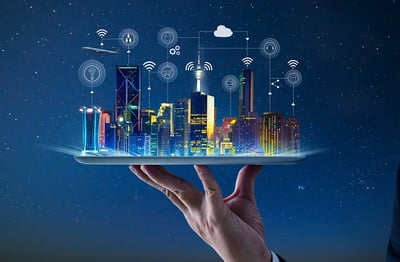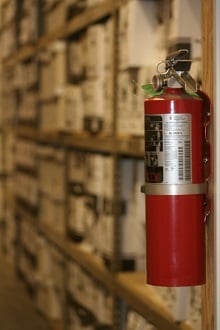 The power of the “Internet of Things” to unlock intelligent building features is here and more than likely already appearing in a comfortable, well-lit space near you now. Now that seamless connectivity of smart devices is a reality, we look at how the Internet of Things impacts building management system (BMS) design today and creates new possibilities for tomorrow.
The power of the “Internet of Things” to unlock intelligent building features is here and more than likely already appearing in a comfortable, well-lit space near you now. Now that seamless connectivity of smart devices is a reality, we look at how the Internet of Things impacts building management system (BMS) design today and creates new possibilities for tomorrow.
IoT Devices: Small, Smart, and In Charge
With demanding clients and investors, rising overheads, and ever-tighter emissions targets, facility owners and managers have been looking to technology—and specifically intelligent building features—to help keep tenants cool under the collar and costs under control.
Many have been pinning their hopes on the much-heralded “Internet of Things” (IoT) for the kind of seamless device connectivity that will unlock facility-wide efficiencies and deliver real returns on investments in intelligent building design.
The wait may now be over. A new generation of open-protocol control devices finally allows smart IoT sensors to talk directly both with legacy backbone HVAC and power systems while sharing data in real-time with centralized facility management software.
The result is BMS implementations that offer comfort, convenience, and safety when and where it’s needed while achieving measurable reductions on input costs, maintenance, labor, carbon emissions, and client callouts.
To understand how that all looks in practice, let’s start by explaining exactly what the IoT is and why it’s important to your BMS.
What Exactly Is the Internet of Things?
The Internet of Things refers to any device that can be connected directly to the Internet using its own onboard systems and common standards like the Internet Protocol (IP). Any device that has its own IP address can theoretically be connected to other IP devices via any number of wireless or wired (usually Ethernet) connections.
That means that even the simplest IoT device can both share data and receive instructions directly from other devices rather than going through a conventional centralized network hub that analyzes incoming data and then allocates tasks across devices connected to the system.
How Will the Internet of Things Impact Buildings?
IoT technology means that almost any device—from a lightbulb to a video camera to an HVAC damper—can not only be controlled remotely but can also share information with the entire network. That enables integrated BMSs to work together to collect vast amounts of detailed local information across an entire network.
All this information allows your BMS to:
- Respond in real-time to fluctuations in temperature or building occupancy, or dynamic threats like flooding or a security breach
- Leverage advanced data analytics and machine learning algorithms to increase network efficiency by trimming margins and increasing economies of scale
- Allow IoT devices in BMS subsystems to respond independently to local conditions
 What Is Leading IoT and BMS Innovation?
What Is Leading IoT and BMS Innovation?
The key to unlocking the potential of IoT devices is a smart middle layer of technology that uses the same open-source IP protocols as these devices, as well as specialized non-proprietary standards like BACnet. This technology connects IoT devices both to your existing building automation infrastructure and to specialized building management and analysis software.
Companies like Tridium, Distech Controls, Honeywell, Johnson Controls, Siemens, and Cylon Auto-Matrix—as well as specialist suppliers like MACC—are at the forefront of this open-source revolution. They are finding new ways to add value for building operators by:
- Liberating consumers from single-supplier proprietary systems
- Increasing integration and dispersed functionality across BMSs
- Keeping legacy automation and BMS infrastructure in use longer
- Making maintenance, troubleshooting, and future equipment upgrades easier
Existing and Emerging Intelligent Building Features
What does this mean for you as a client-facing facility owner or operator? Let’s look at some actual and emerging intelligent and IoT-building features.
Advanced Environmental Control
Connected sensors, smart subsystems, and real-time data analytics are taking building climate control to a new level. Temperature and ventilation can be adjusted in an individual office or meeting room to take account of variables like:
- Outside ambient temperature
- Time of day
- Number of occupants
- Activity levels
Systems can even be integrated with your office calendar so temperatures are adjusted ahead of time for unusually high or low levels of occupancy. That means less expensive last-minute thermostat overrides and more customizable options. It also means smoother demand peaks, better energy efficiency, and more predictable energy bills.
It’s also better for your building occupants. IoT sensors can monitor levels of carbon monoxide and volatile organic compounds in real-time and activate extra ventilation capacity or increased filtration as required.
Improved ventilation can also have a real effect on productivity in your building. One study found that investing less than $40 per employee per year in improved ventilation systems can increase productivity by 8%.
Efficient Lighting Design
In the same way, building lighting can be delivered to individual areas in line with variables like:
- Outside ambient light
- Time of day
- Room requirements (e.g. dimmed lights for presentations)
- Occupancy levels
- Safety and security concerns
Light sensors can turn on local arrays of ultra-efficient LED lights in areas as needed, rather than keeping entire floors lit up just to accommodate a handful of late workers. They can also dim and power up lights on a schedule to smooth demand peaks. According to one survey, fully automating the lighting in a building could reduce costs by as much as 20-30%.
Smart Sanitation and Water Supply
Bathrooms, kitchens, and devices like dishwashers and sterilization equipment can be big water consumers. You can reduce your water bills and improve your environmental impact by attaching smart IoT to utility meters or water heaters for monitoring. If necessary, you can control water consumption—or at least make sure the right person is getting the bill.
Smart sanitation systems can also lower costs and improve the health and comfort levels of your tenants. IoT-enabled sensors can monitor the performance of everything from automatic paper hand towel rolls to soap dispensers to hand dryers.
Smart Entry and Intelligent Security
Connecting your building security systems via IoT technology can increase overall safety and improve your staff’s ability to respond to threats and dynamic events. IoT sensors and controllers can be connected to:
- Access control systems including smartcard readers and proximity sensors as well as biometric devices like fingerprint or retinal scanners and facial recognition systems
- Security cameras and movement detectors
- Employee identification information
In a fully integrated security system, employee access opens up only specific areas that the employee needs, but also triggers other services such as associated climate and temperature control, elevators, lighting, WiFi, or network access.
 Self-Diagnosing Systems
Self-Diagnosing Systems
One of the biggest emerging advantages of integrated IoT-enabled BMSs is the ability to self-diagnose problems and adjust systems to reduce the potential impact.
For instance, sensors attached to HVAC equipment can detect unscheduled demand spikes or sudden losses of performance. They could bring additional HVAC capacity online or shut down equipment to prevent damage or wasteful operation. These sensors could even be used to trigger maintenance calls to equipment suppliers.
Similarly, fire extinguishers deployed at Virginia Commonwealth University are now equipped with Bluetooth devices that monitor both tank pressure and proximity to a mounting.
They are also capable of notifying facility managers if the extinguisher either loses pressure or is removed from the mounting.
Disaster Avoidance
In worst-case scenarios, effective self-diagnosing systems can help mitigate catastrophic failures or disasters.
That can be as mundane as shutting down the water supply to a bathroom when a spike in demand is detected to limit damage from a failing hot water heater.
It can also be as critical as connecting smart gas sensors directly to your building’s integrated security system so evacuation protocols are triggered when a dangerous gas leak is detected.
MACC: Your Intelligent Building Design Partner
Many of the systems described here are already in place or emerging as part of modern BMS design. But the limits to what smart IoT sensors, integrated systems, and flexible open-source control equipment can achieve in terms of intelligent building design have yet to be reached.
Emerging BMS technologies can help you cut costs, improve building performance, and maximize return on investment by integrating more of your traditional building automation infrastructure with cutting-edge sensor and control systems. To find out how to do this, it’s important to work with a partner who understands both your needs and your budget.
At MACC, we have decades of experience building and upgrading BMSs for a wide range of industries and property types. We’re dedicated to providing robust open-source equipment that works with your existing equipment while adding functionality and performance to your facility.
We are a registered supplier of Tridium, Distech Controls, Honeywell, Johnson Controls, Siemens, and Cylon Auto-Matrix equipment. Contact us today to find out how we can help you make the most of emerging IoT technologies and open-source control capabilities with smart, affordable, and scalable solutions.














